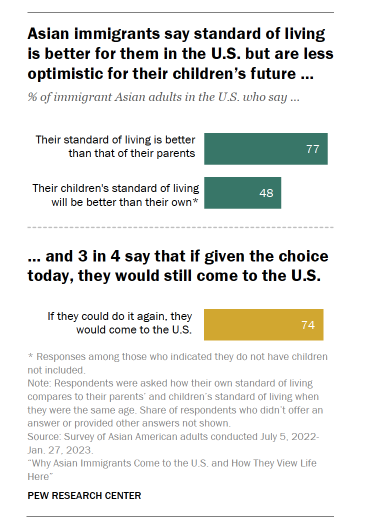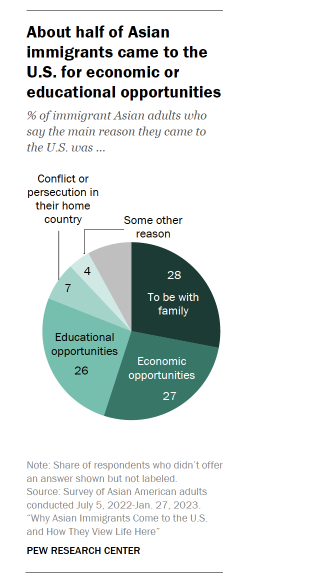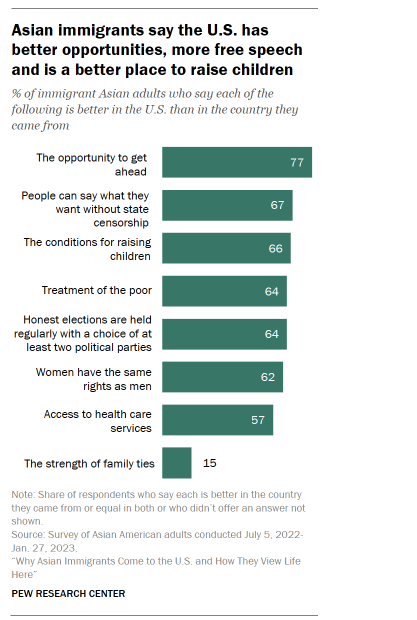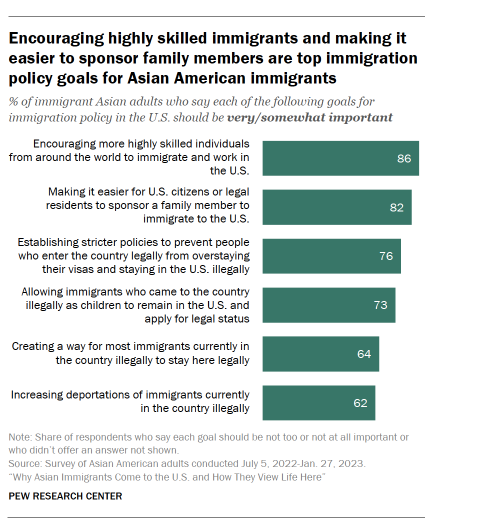Asian immigrants are from all over Asia. It constitutes an important part of the overall American immigration.: The three largest immigrant groups in the United States are from India (2.8 million), China (2.5 million) and the Philippines (2 million).
International immigration and participation in the U.S. immigration system has diverse sources and experiences, forming an important part of the lives of many Asian Americans. Furthermore, Asian immigrants’ experience of immigration is closely related to their perceptions of federal government priorities in immigration policy.

A new analysis of Pew Research Center’s 2022-23 survey of Asian American adults finds that Asian immigrants overall give positive assessments of their lives in America compared with their origin country. A large majority (77%) say their standard of living is better than that of their parents in their home countries. At the same time, Asian immigrants are less optimistic about their children’s standard of living being better than their own, and more than half say the country is generally headed in the wrong direction. Still, most (74%) say they would migrate to the U.S. again if given the choice today.
More than half of Asian immigrants say the nation’s immigration system needs large changes (59%). And when asked about U.S. immigration policy goals, attracting highly skilled immigrants to the U.S. is one of the top priorities (86%).
These findings come from Pew Research Center’s multilingual, nationally representative survey of 7,006 Asian American adults, including 5,036 Asian immigrants, conducted from July 5, 2022, to Jan. 27, 2023.
A brief history of Asian immigration to the U.S.
Asian immigrants have followed many pathways in coming to the United States. About a quarter each say they came to the U.S. to be with family (28%) or to seek economic (27%) or educational (26%) opportunities. A smaller share (7%) say they came to escape from conflict or persecution in their origin country.
Reasons for immigrating vary across Asian ethnic groups, reflecting the diverse histories of their origin countries.
· About 40% each of Filipino and Indian immigrants came to the U.S. for economic opportunities – a higher share compared with Korean (26%), Chinese (16%) and Vietnamese (9%) immigrants.
· 32% of Vietnamese immigrants say they came to the U.S. to escape conflict or persecution; by comparison, fewer than 5% of Chinese, Indian, Filipino and Korean immigrants say the same.

Asian immigrants faced many adjustments navigating their new lives in the U.S. Among them are:

Nearly all Asian immigrants (91%) say speaking English is important to succeed in the U.S., and roughly two-thirds (64%) say they had learned English before immigrating. Asian immigrants who arrived in the last decade are more likely to say they learned to speak English before arriving than those who came to the U.S. more than 20 years ago (89% vs. 57%).

About six-in-ten Asian immigrants (58%) say they received financial assistance in some way after they arrived in the U.S. But whether they received help – and from what sources – varies by their motivation for immigrating:
· 64% of those who immigrated to escape conflict report receiving government financial assistance in their first six months in the country.
· About 10% of Asians who came for other reasons, such as educational, economic or family motives, say the same.
Overall, majorities of Asian immigrants see the U.S. as better than their origin country on nearly all measures asked about in the survey. Some of the qualities seen most positively about the U.S. include:
· 77% see the U.S. as better than their origin country for the opportunity to get ahead.
· 67% say the U.S. is better when it comes to freedom of speech.
· 66% say it is better for raising children.
But the U.S. is not universally seen as better: On the strength of family ties, only 15% of Asian immigrants say the U.S. is better than their origin countries. Instead, 60% say their origin country is better on this measure.

Follow us